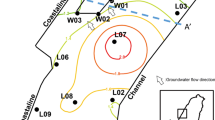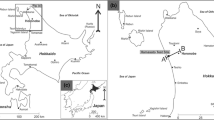Abstract
The movement of underlying saline water inresponse to freshwater abstraction infresh-saline aquifers is dependent uponaquifer properties, well design andoperational plans. The responses of thesefactors under various well configurationsand pumping modes are important forsustainable freshwater abstraction. In thepresent study, three shallow skimming wellswith different well configurations weremonitored under different pumping modes inthe Indus basin of Pakistan. The field datawere used to calibrate MODFLOW and MT3Dmodels for each well system. The resultsshowed that the selected models have thecapability to simulate both the continuousand intermittent pumping operations inskimming wells. The calibrated models wereused to evaluate the sensitivity of variousaquifers, well design, and operationalparameters. Hydrosalinity of the pumpedwater increased with the increase invertical hydraulic conductivity,longitudinal dispersivity, well abstractionrate, well penetration ratio, and pumpingduration; while increase in horizontalhydraulic conductivity, effective porosity,specific yield, freshwater recharge,transverse dispersivity, and number ofboreholes in multi-borehole skimming wellsdecreased the salinity of the pumpedwater.
Similar content being viewed by others
References
ACE 1997. Hydrogeological and groundwater mathematical models studies. Second SCARP transition, North Rohri Pilot Project, Completion Report. 147 p.
Ahmed N. 1979. Groundwater Resources of Pakistan. Shahzad Nazir, 61-B/2 Gulberg-3, Lahore, Pakistan. 810 p.
ASCE 1969. Saltwater intrusion in the United States. Journal of Hydraulic Division, ASCE (HY5): 1651-1669.
Bachu S. 1995. Flow of variable density formation in deep sloping aquifers: review of methods of representation with case studies. Journal of Hydrology 164: 19-38.
Bear J. 1970. Hydraulics of Groundwater. McGraw-Hill, Inc. 414 p.
Bear J. & Dagan G. 1964. The unsteady interface below coastal collector. Hydraulic Laboratory Progress Report 3. Israel Institute of Technology, Haifa, Israel, 123 p.
Bear J., Zaslavasky D. & Irmay S. 1968. Physical Principles of Water Percolation and Seepage.UNESCO, Paris. 465 p.
Bennett G.D., Mundorft M.J. Hussain S.A. 1968. Electric analog studies of brine coning beneath fresh water wells in the Punjab region, Pakistan. U.S. Geological Survey. Water Supply Paper 1608-J: J1-J31.
Boumans J.H., Hoorn J.W. van, Kruseman G.P. & Tanwar B.S. 1988.Watertable control, reuse and disposal of drainage water in Haryana. Agricultural Water Management 14: 537-545.
Chandio B.A. & Larock B.E. 1984. Three-dimensional model of a skimming well. Journal of Irrigation and Drainage Engineering, ASCE 110(3): 275-288.
Cooper H.H. 1959. A hypothesis concerning the dynamic balance of fresh water and saltwater in a coastal aquifer. Journal of Geophysical Research 64(4): 461-467.
Dahri Z.H. 2002. Suitability of shallow skimming wells for sustainable management in the Lower Indus basin of Pakistan. M.Sc. thesis. Centre of Excellence in Water Resources Engineering, University of Engineering and Technology, Lahore, Pakistan. 120 p.
Essaid H.I. 1990. The computer model SHARP, a quasi-three dimensional finite difference model to simulate fresh water and saltwater flow in layered coastal aquifers systems. U.S.
Geological Survey, Water Resources Investigation Report 90-4130; 181 p.
Frind E.O., 1982. Simulation of long-term transient density dependent transport in groundwater. Advances in Water Resources 5: 73-88.
Haubold R.G. 1975. Approximation of steady interface beneath a well pumping fresh water overlying saltwater. Ground Water 13(3): 254-259.
Hem J.P. 1985. Study and interpretation of chemical characteristics of natural water. USGS water supply paper 2254; 263 p.
Henry H.R. 1959. Salt intrusion into fresh water aquifers. Journal of Geophysical Resources 64(11): 1911-1919.
Henry, H.R., 1964. Effects of dispersion on salt encroachment in coastal aquifers. In: Sea Water in Coastal Aquifers (1613-C, pp. 70-84). U.S. Geol. Surv., Water-Supply Paper.
Holm E.J. & Langtangen H.P. 1999. A method for simulating sharp fluid interfaces in groundwater flow. Advances in Water Resources 23: 83-95.
Huyakorn P. & Taylor C. 1976. Finite element models for coupled groundwater flow and convective dispersion. Proc. First Int. Conference on Finite Elements in Water Resources, Princeton University, Princeton, N.J., USA: 1.131-1.151.
Kahlown M.A. 1992. Saline water upconing as affected by aquifer, fluid and skimming well parameters. Ph.D. Dissertation, University of Idaho, USA.
Kashef A.-A.I. 1975. Comparative study of fresh-salt water interfaces using finite element and simple approaches. Water Resources Bulletin 11(4): 651-665.
Kashef A.-A.I. & Smith J.C. 1975. Expansion of salt-water zone due to well discharge. Water Resources Bulletin 11(6): 1107-1120.
Kemper W.D., Jahangir M. & McWhorter D.B. 1976. Skimming well report: Field studies. Publication No. 67, Mona Reclamation Experimental Project, Water and Power Development Authority (WAPDA), Bhalwal, Pakistan; 24 p.
Ledoux E., Sauvagnac S. & Rivera A. 1990. A compatible single-phase/two-phase numerical model: 1. Modeling the transient salt-water/fresh-water interface motion. Groundwater 28(1): 79-89.
McDonald M.G. & Harbough A.W. 1988. MODFLOW: A modular 3D finite difference groundwater flow model. U.S. Geological Survey. Open File Report 83-875; 528 p.
McElwee C. & Kemblowski M. 1990. Theory and application of an approximate model of saltwater upconing in aquifers. Journal of Hydrology 115: 139-163.
McWhorter D.B. 1972. Steady and unsteady flow of fresh water in saline aquifers. Water Management Technical Report No.20, Colorado State University, Fort Collins, USA; 49 pp.
Muskat M. & Wyckoff R.D. 1935. An approximate theory of water-coning in oil production. Transaction of American Institute of Mining, Metallurgy and Petroleum Engineering, Vol. 114; pp. 144-163.
Pinder G.F. & Cooper H.H. 1970. A numerical technique for calculating the transient position of the saltwater front. Water Resources Research 6(3): 875-882.
Reilly T.E. & Goodman A.S. 1987. Analysis of saltwater beneath a pumping well. Journal of Hydrology 89: 169-204.
Rushton K.R. 1980. Differing position of saline interfaces in aquifers and observation boreholes. Journal of Hydrology 48: 185-189.
Saeed M.M. 2003a. Survey of current practices, assessment of modeling tool and development of guidelines for improving design and operation of skimming wells in Pakistan. Ph.D. dissertation. Department of Civil Engineering, University College Dublin, Ireland; 260 pp.
Saeed M.M., Ashraf M. & Bruen M. 2002a. Diagnostic analysis of skimming well technologies in the Indus basin. Irrigation and Drainage Systems 16(2): 139-140.
Saeed M.M., Bruen M. & Asghar M.N. 2002b. A review of modeling approaches to simulate saline-upconing under skimming wells. Nordic Hydrology 33(2/3): 165-188.
Saeed M.M., Ashraf M. & Asghar M.N. 2003b. Hydraulic and hydrosalinity behavior of skimming wells under different pumping regimes. Agricultural Water Management 61: 163-177.
Sufi A.B., Latif M. & Skogerboe G.V. 1998. Simulating skimming well techniques for sustainable exploitation of groundwater. Irrigation and Drainage Systems 12: 203-226.
Volker R.E. & Rushton K.R. 1982. An assessment of the importance of some parameters for seawater intrusion in aquifers and a comparison of dispersive and sharp-interface modeling approaches. Journal of Hydrology 56: 239-250.
Voss C.I. 1984. A finite element simulation model for saturated-unsaturated fluid density dependent groundwater flow with energy transport or chemically reactive single species solute transport (SUTRA). U.S. Geological Survey, Water Resources Investigation Report 84-7369; 249 p.
Wang F.C. 1965. Approximate theory of skimming well formation in the Indus Plain of West Pakistan. Journal of Geophysical Research 70(20): 5055-5063.
WAPDA 1965a. Lower Indus Report: Physical Resources-Groundwater, Vol. 6, Supplement. Water and Power Development Authority (WAPDA), Pakistan; pp. 6.1-6.7.
WAPDA 1965b. Lower Indus Report: Principle and criteria for future development-Groundwater development, Part 19.5 skimming wells. Water and Power Development Authority (WAPDA), Pakistan; pp. 3-59.
Whitefield M.S. Jr. 1975. Geohydrology and water quality of the Mississippi River Alluvial Aquifer, northeastern Louisiana. Louisiana Department of PublicWorks,Water Resources Technical Report No. 10; 29 p.
Zheng C. 1990. MT3D: A modular 3D Transport Model. S.S. Papadopulos and Associates, Inc., Rockville, Maryland, USA.
Author information
Authors and Affiliations
Rights and permissions
About this article
Cite this article
Saeed, M., Bruen, M. Simulation of Hydrosalinity Behavior Under Skimming Wells. Irrigation and Drainage Systems 18, 167–200 (2004). https://doi.org/10.1023/B:IRRI.0000040252.33428.3a
Issue Date:
DOI: https://doi.org/10.1023/B:IRRI.0000040252.33428.3a




